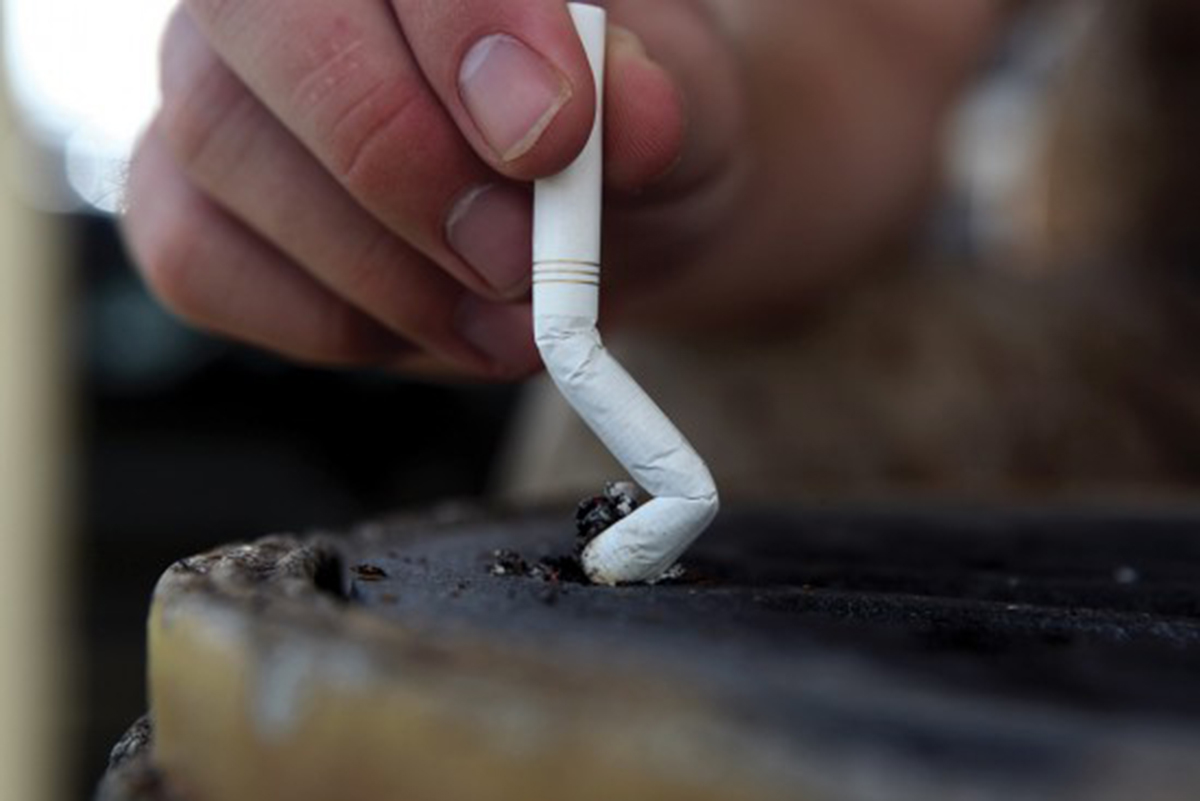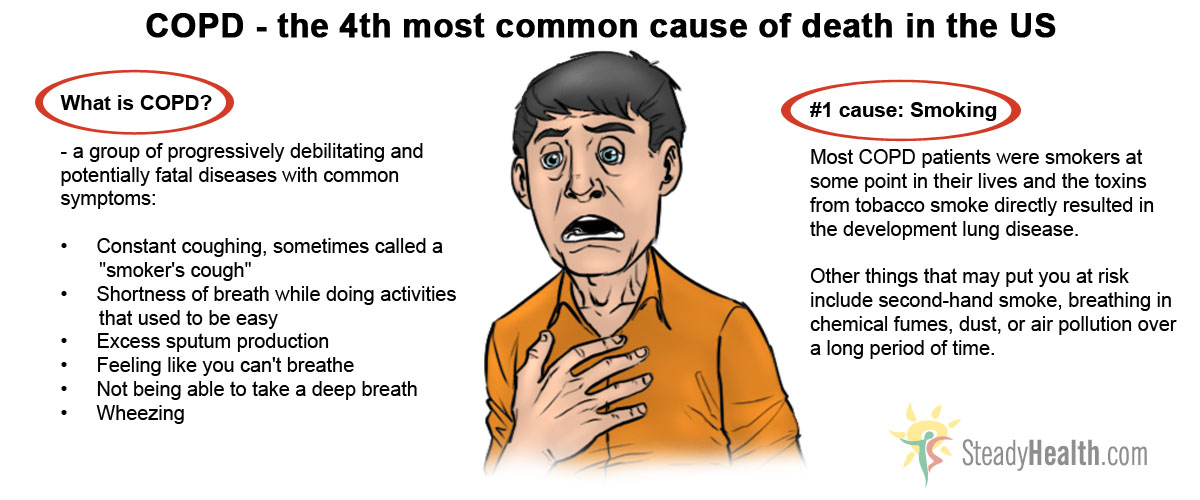What is COPD?
Despite the name, Chronic Obstructive Pulmonary Disease (COPD) is not a single disease. It's actually a group of progressively debilitating and potentially fatal diseases with common symptoms.
To put it simply, they make it hard to breathe. And when it's always hard to breathe, it can be hard to live your life to the fullest. Or even to live at all.
How do you get COPD?
Well, there are a few causes, but the absolute number one cause of chronic obstructive pulmonary disease is smoking.
There are some unfortunate patients who never smoked themselves, but lived or worked in smoke-filled environments and wound up with lungs damaged by secondhand smoke. Most of these people, both the smokers and those exposed to secondhand smoke, are usually diagnosed with COPD in their 50s or 60s. There is an even smaller subset of the population, though, that genetically lacks an enzyme named alpha-1 antitrypsin. This deficiency causes them to develop COPD, among other chronic conditions, usually in their 40s.
What is the difference between the types of COPD?
Emphysema, from the Greek word emphysan, which means 'to inflate,' is trapped air or gas. The tiny chambers of the lungs, the alveoli, are destroyed. These spaces are the primary locations where gas exchange takes place.
Take a deep breath. You have to work to bring air into your lungs, but when you stop making an effort the natural elasticity of your lungs causes them to contract and push the air back out. Think of how much harder it is to blow up a balloon than it is to let all of the air escape. The elasticity of the balloon forces the air out easily while the balloon contracts in size, just like your lungs. Emphysema takes that natural elasticity away. You have to work to get the air out as well. When it takes twice as much effort to breathe as normal (or more), there are serious, debilitating effects on your overall health.
Read More: Is There A Natural "Cure" For COPD?
Chronic Bronchitis, however, is not so much lung destruction as lung blockage. In order to be diagnosed, a person has to have a productive cough for at least three months in two consecutive years. That's at least six months of coughing up the overabundance of mucus being produced by the tracheobronchial tree. The tracheobronchial tree is the structure that the encompasses all of the airways of the lungs. With all of that mucus in the way, it's extremely difficult to get enough air into the lungs and enough carbon dioxide out of them. Chronic bronchitis sufferers are almost drowning in their own secretions.
What's life like when you're living with COPD?
In a word, hard. It makes sense, of course, when you recognize air and breathing as the foundation of any living person's hierarchy of needs.
Breathlessness and physical limitations may restrict social activities, hobbies, and travel. People with COPD may experience feelings of frustration, anxiety, and depression due to the impact on their independence and overall well-being.

Emphysema and Impaired Gas Exchange
Our bodies require a delicate dance of oxygenation and carbon dioxide elimination. If either partner stumbles, disaster results. To people with COPD from emphysema, the most pressing symptom is a constant hunger for air. It's as if they are always just finishing up a hard run, trying to catch their breath. Because they can't catch their breath, they can experience visual disturbances and even anxiety to the point of feeling a sense of impending doom.
Family members and friends report that those with COPD from emphysema can appear confused, restless, or irritable. They may be lethargic, with pale or dusky skin. The increased effort of breathing is evident in their abnormal breathing patterns and flared nostrils. They may even sweat from the increased effort to breathe.
Being Unable to Clear Your Lungs Doesn't Help
Remember the whole "drowning in their own secretions" thing? It's not hyperbole. COPD sufferers on the bronchitis side are literally doing just that. The chronic cough is their body's attempt to clear the buildup of mucus, but it's simply ineffective.
They, of course, have a constant hunger for air also. If you took a stethoscope and listened to their lungs, you would hear a cacophony instead of the measured breathing of a normal person. In the medical world, these are rales and crackles (crackling, popping sounds), rhonchi (a squeaking or snoring sound), and wheezes (a continuous musical sound, like a whistle). There is a constant, wet cough, but it's weak and ineffective. People with COPD from chronic bronchitis can have trouble speaking and may seem panicky, with wild eyes and restless movements. They may even have a blue tinge to their skin.
What Can Be Done?
The first thing is to quit smoking. Immediately.
While the damage already done is, unfortunately, irreversible, you can at least minimize the progression of the disease by eliminating the toxic effects of tobacco smoke. The second thing is to protect your lungs by keeping your flu and pneumococcal vaccinations up to date.
Read More: COPD Caused Anxiety and Depression
The tough part about COPD treatment is that options are limited and of the ones available, almost all come with serious side effects. A common medication is ipratropium, which is an inhaled powder that helps to open up the bronchial passages. Bronchodilators, including short-acting and long-acting bronchodilators, help relax the muscles around the airways, making breathing easier. Inhaled corticosteroids may be prescribed to reduce airway inflammation. Other medications, such as phosphodiesterase-4 inhibitors or antibiotics, may be used in specific cases.
For those with severe COPD, supplemental oxygen may be required, which means toting around an oxygen tank. Oxygen therapy can improve symptoms, enhance exercise tolerance, and prolong survival in individuals with low blood oxygen levels. Steroid therapy can help reduce the inflammatory symptoms of COPD, but long-term steroid use can lead to a plethora of complications like diabetes, osteoporosis, and thinning of the skin.
Pulmonary rehabilitation programs are designed to help improve the overall quality of life for individuals with COPD. These programs typically include exercise training, education about COPD and self-management techniques, breathing exercises, nutritional counseling, and psychological support. Participating in pulmonary rehabilitation can enhance exercise capacity, reduce symptoms, and improve overall well-being.
The good thing about COPD is that, barring genetic deficiencies, you can prevent it from developing in the first place. Quit smoking. Even better, don't even start. Protect your lungs; you're going to need them.
- Chronic obstructive pulmonary disease. (2001). In Taber's Cyclopedic Medical Dictionary (pp.584-585, Edition 19). Philadelphia, PA: F. A. Davis Company.
- Emphysema. (2001). In Taber's Cyclopedic Medical Dictionary (pp.663-664, Edition 19). Philadelphia, PA: F. A. Davis Company.
- Bronchitis, chronic. (2001). In Taber's Cyclopedic Medical Dictionary (pp.286-287, Edition 19). Philadelphia, PA: F. A. Davis Company.
- Mindmap by steadyhealth.com
- Photo courtesy of MilitaryHealth by Flickr : www.flickr.com/photos/militaryhealth/8652395915/


